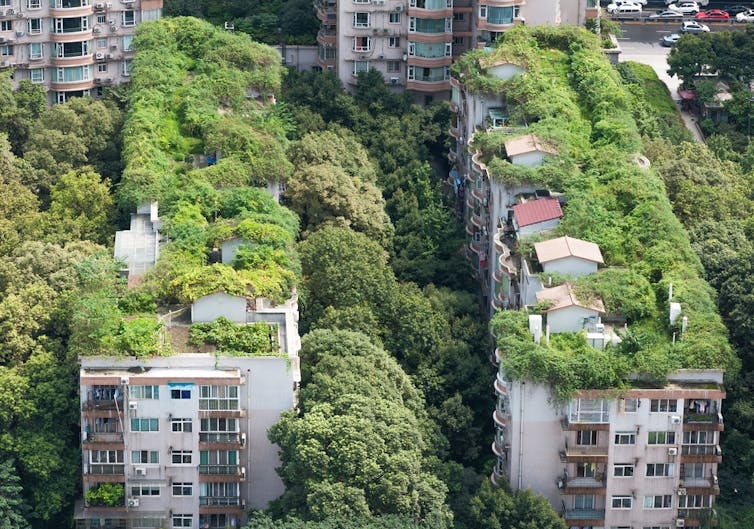[ad_1]
On colour-coded temperature charts, the Indian subcontinent is presently a sickly mauve. With summer time nonetheless months away, an unusually intense heatwave is threatening thousands and thousands of individuals there. Temperatures are anticipated to exceed 48°C on the border between Pakistan and India this week. A month in the past, the warmth broke a 122-year-old file. What can folks do to climate the worst and put together for a future of utmost warmth?

Don’t have time to examine local weather change as a lot as you’d like?
Get a weekly roundup in your inbox as a substitute. Each Wednesday, The Dialog’s setting editor writes Think about, a brief e mail that goes just a little deeper into only one local weather problem. Be a part of the ten,000+ readers who’ve subscribed thus far.
For a lot of Indians and Pakistanis, notably in rural areas, the insupportable warmth will slash the precious hours obtainable to work outdoor. In response to analysis revealed by the Lancet, greater than 150 billion work hours had been misplaced in 2018 on account of excessive temperature and humidity. This development can have world penalties.
“Half of the world’s meals is produced by smallholder farms with many of the vitality enter from bodily labour carried out by the farmers,” says Mark Maslin, professor of Earth system science at UCL. “Because the world warms, there shall be increasingly days when it will likely be bodily not possible to work exterior, decreasing productiveness and meals safety.”
In cities, the place an rising share of the worldwide inhabitants lives, there are alternatives to make streets extra comfy throughout bouts of utmost warmth. One of the crucial common, with wider potential advantages for wildlife in search of habitat, is city greening – or making more room for timber and different vegetation amid the concrete sprawl.
However a examine led by Cardiff College’s Mark O. Cuthbert, revealed in February, discovered that carpeting roofs and partitions with greenery and weaving inexperienced corridors between expanded parkland can both subdue floods or mitigate warmth, however it may’t do each in a single metropolis.
In response to Cuthbert and his co-authors, Denis O’Carroll of UNSW Sydney in Australia and Gabriel C Rau of Karlsruhe Institute of Expertise in Germany, the explanation cities are likely to overheat in scorching climate and flood throughout heavy rainfall is identical. The abundance of concrete and metal soak up and retain warmth, whereas those self same sealed surfaces “can’t act like a sponge to take in and retailer rain, in contrast to the soil they’ve changed”.
The researchers argue that greener cities in areas of excessive rainfall – comparable to across the northern Europe and across the equator – are prone to offset stronger heatwaves as a result of crops launch water vapour throughout photosynthesis, which has a cooling impact.
The analysis group expects the advantages of city greening to be much less pronounced in drier areas the place there’s loads of vitality from sunshine, however rainfall is extra restricted, like cities in India and Pakistan. However increasing inexperienced areas in these locations remains to be worthwhile, as that is the place there may be the best potential for water retention by soils, which might help to forestall floods.

LP2 Studio/Shutterstock
A report revealed throughout COP26, the latest UN local weather change summit in November 2021, urged that Africa is heating sooner than different areas of the world. Abdu Mohiddin, an assistant professor at Aga Khan College in Kenya, says that by 2030 as much as 118 million extraordinarily poor folks shall be topic to the devastating impacts of drought and intense warmth.
Mohiddin says the continent wants fast monetary and technological help to adapt to the warming setting, in addition to analysis funding to evaluate who and the place is most weak.
In these areas and others, designs and constructing strategies sourced from conventional structure can provide a few of the most cost-effective and most sustainable types of aid. Amin Al-Habaibeh, a professor of clever engineering techniques at Nottingham Trent College, research the methods builders have helped hold folks cool for hundreds of years within the Persian Gulf (one other hotspot for intensifying heatwaves).
Right here, houses constructed with limestone and different pure supplies soak up moisture when it’s humid and launch it via evaporation on scorching and sunny days. This supplies a slight cooling impact, Al-Habaibeh says. The sandy texture and color of the buildings additionally displays numerous photo voltaic radiation.
Slender roads and alleys maximise shadows, whereas glass is scarce and home windows small to take care of air move however hold out the Solar’s warmth. Inner courtyards funnel scorching air upwards at noon (when the solar is at its peak) and exchange it with cooler air from the environment rooms, he says.
Whereas ingenuity and solidarity might help communities adapt to more and more brutal heatwaves, there’s a restrict, say Tom Matthews and Colin Raymond, local weather scientists at King’s School London and California Institute of Expertise, respectively.
“The vary of climate people can encounter on Earth – the ‘local weather envelope’ – is shifting because the planet warms,” they warn. “Circumstances totally new to civilisation might emerge within the coming a long time.” Which means warmth extremes that exceed what people can survive.
A 2021 examine reported that one in three deaths attributable to excessive warmth since 1991 might be linked to local weather change. If you end up in a warmth wave, Chloe Brimicombe, a PhD candidate learning local weather change and its penalties for human well being on the College of Studying, has some recommendation for staying secure: “Preserve cool. If indoors, attempting bathing your ft in chilly water or have a bathe … Shut the curtains and open home windows on the facet not going through the solar,” she says.
Different measures that hold air flowing all through the constructing embrace opening doorways and turning on followers.
Brimicombe stresses that it’s essential to remain hydrated, as you lose numerous water via sweat throughout heatwaves. “Drink extra typically than you normally would, even if you don’t really feel thirsty,” she says. And don’t overlook to test on individuals who might have further assist.
“Look out for over 65s, pregnant ladies, kids underneath 5 and people with medical circumstances. These teams are all extra weak to warmth. You must also keep away from being in direct daylight between 12pm and 3pm when the Solar is at its strongest.”
[ad_2]
Source link














